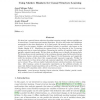Free Online Productivity Tools
i2Speak
i2Symbol
i2OCR
iTex2Img
iWeb2Print
iWeb2Shot
i2Type
iPdf2Split
iPdf2Merge
i2Bopomofo
i2Arabic
i2Style
i2Image
i2PDF
iLatex2Rtf
Sci2ools
JMLR
2008
2008
Using Markov Blankets for Causal Structure Learning
We show how a generic feature selection algorithm returning strongly relevant variables can be turned into a causal structure learning algorithm. We prove this under the Faithfulness assumption for the data distribution. In a causal graph, the strongly relevant variables for a node X are its parents, children, and childen's parents (or spouses), also known as the Markov blanket of X. Identifying the spouses leads to the detection of the V-structure patterns and thus to causal orientations. Repeating the task for all variables yields a valid partially oriented causal graph. We first show an efficient way to identify the spouse links. We then perform several experiments in the continuous domain using the Recursive Feature Elimination feature selection algorithm with Support Vector Regression and empirically verify the intuition of this direct (but computationally expensive) approach. Within the same framework, we then devise a fast and consistent algorithm, Total Conditioning (TC),...
Related Content
| Added | 13 Dec 2010 |
| Updated | 13 Dec 2010 |
| Type | Journal |
| Year | 2008 |
| Where | JMLR |
| Authors | Jean-Philippe Pellet, André Elisseeff |
Comments (0)

